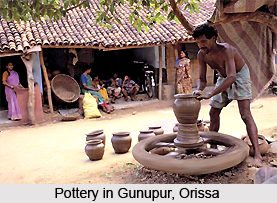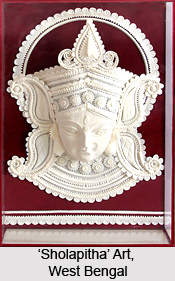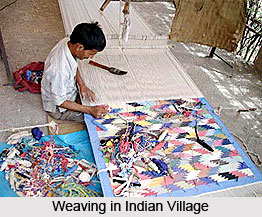 Art as occupation in Indian villages has been existent since ancient ages and has been one of the major sources of livelihood for the millions of inhabitants of these rural parts of the country. The main art forms which have enabled Indian villages to earn their daily bread are pottery work, weaving, handicrafts, Madhubani paintings, Patachitra paintings and several other forms of art. Metal art and different types of tribal art, performed by numerous Indian tribes are practised as significant occupation of the residents of several Indian villages.
Art as occupation in Indian villages has been existent since ancient ages and has been one of the major sources of livelihood for the millions of inhabitants of these rural parts of the country. The main art forms which have enabled Indian villages to earn their daily bread are pottery work, weaving, handicrafts, Madhubani paintings, Patachitra paintings and several other forms of art. Metal art and different types of tribal art, performed by numerous Indian tribes are practised as significant occupation of the residents of several Indian villages.
Pottery
Pottery products in Indian villages have been existent since the era of Indus Valley Civilisation. Hand-made and wheel-made pottery art forms are available which include glazed and unglazed pottery. Black pottery also forms a popular occupation for Indian villagers. Alwar and Kanpur are famous for making thin pottery with incised designs. The villages of Kangra District in Himachal Pradesh are renowned for black pottery while Pokhran, Rajasthan possesses stylised forms with incised decorative patterns. The villages in the places like Delhi, Amritsar, Jaipur, Khurja, Chunar and Rampur in Uttar Pradesh and Karigari in Tamil Nadu are famous for making glazed pottery with white background and blue and green patterns. Earthenware vessels, jars, pots, containers, `surahis`, stools, ceramic pottery items and innumerable other pottery handicrafts are manufactured by Indian villagers and sold throughout India.
 Weaving
Weaving
Natural fibres like wool, silk and cotton are utilized for weaving in Indian villages. Sometimes, synthetic fibres like nylon are also used. In the villages of this country, weaving is believed to be one of the largest cottage industries. `Daccai`, `Taant` and `Jamdani` are some of the well-known fabrics woven in West Bengal, which are in high demand in India and abroad. Chanderi design of Madhya Pradesh, Surat `Tanchoi`, `Baluchari`, `Benarasi` and many other fabrics are essential forms of occupation in Indian villages. Manufacturing of Pashmina and Shahtoosh shawls in Kashmir includes a popular occupation in the local villages.
Madhubani Paintings
Women in Indian villages have been practising the art of Madhubani paintings since ancient times. During the 1960s, when many Indian villages were ravaged by droughts, these paintings became a significant source of non-agricultural form of livelihood. Today, Madhubani paintings are celebrated folk arts of the Indian society. Hindu deities like Krishna, Goddess Saraswati, Goddess Lakshmi and others are popular subjects for these arts. Detailed floral patterns, alongwith designs of birds and animals are preferred while performing Madhubani paintings.
 Patachitra Paintings
Patachitra Paintings
Patachitra is a famous art form, indigenous to the state of Orissa which is immensely popular in the entire nation and even globally. It is done on cloth, utilising ordinary, natural hues and extraordinary pictorial conceptions. Tourists visiting India are quite fond of these Patachitra paintings as interesting travel souvenirs. Patachitra paintings are painted on bowls, bottles and the exterior husks of coconuts, besides the traditional ones which are practised on `patta` or treated textiles. Today, there is a great demand for Patachitra paintings on tussar silk.
Metal Art
Numerable districts and villages of the country produce several types of metalworkers who create different products composed of metals which act as significant occupations of Indian villagers. Blacksmiths, goldsmiths, silversmiths and many other kinds of metal artisans are present in these villages who are experts in this field. Rampur district in Uttar Pradesh produces excellent brass handicrafts, while Bastar in Chhattisgarh and hundreds of villages located in West Bengal, Orissa and Bihar are renowned for their various metal items. Bell metal craft of Southern India is celebrated throughout the nation. Engraved metal work, known as `naqashi` is performed in Moradabad region of Uttar Pradesh.
Tribal Art
Dhokra metal art, shell crafts, terracotta, basketry, weaving and many other tribal arts are done in Indian villages to earn revenues by local inhabitants. Pottery work, tribal paintings, paper art, jewellery making and toys manufacturing form an important profession for the villagers here.
 Handicrafts
Handicrafts
The major kinds of rural handicrafts of India are `sholapitha` and terracotta belonging to West Bengal, wood craft, cane craft, shell craft, silver jewellery, and products like `dhurries`, carpets, blankets, rugs, embroidery and clay products of Gujarat. Village fairs or `melas` are amongst the ideal places for the Indian village artisans to display and sell a wide variety of their products. Thousands of other Indian villages are capable of earning money by selling their multiple forms of art.
Apart from agriculture, the above mentioned arts form an important source of occupation for the villagers in this nation. The art of every village is distinctive and reflects the local traditions and customs of the villages. Indian villages specialise in the production of various kinds of handicrafts and other arts which are acclaimed in international markets. People residing in such rural portions of India engage in many art forms, which help them earn revenue.




















